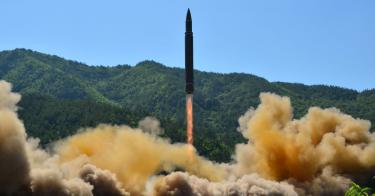Policymakers writing the 2018 National Defense Authorization Act (NDAA) are responsible for crafting new defense policies to deal with an increasingly turbulent and dangerous world.
Sen. Dan Sullivan, R-Alaska, and a bipartisan coalition of cosponsors are working to mitigate North Korea’s nuclear threat by passing the Advancing American Missile Defense Act.
Sullivan’s legislation strengthens the United States’ ballistic missile defense architecture by expanding the ground-based midcourse defense system.
While critics argue the ground-based system is weak and flawed, they are wrong. It is is the only U.S. system capable of eliminating an intercontinental ballistic missile (ICBM) during its midcourse phase of flight.
The system has recently had a successful test shooting down an ICBM-like target under demanding stress conditions, a feat once thought technologically impossible.
Flashpoints are occurring at every corner of the globe, but none as threatening as North Korea’s aggressive nuclear expansion.
North Korea actually demonstrated a capability to reach the U.S. homeland with its most recent ballistic missile test, making the need for developing the ground system ever more pressing.
North Korea could have material for as many as 100 warheads by 2020, as well as skills to mate these warheads to ICBMs. It is not a question of whether North Korea will marry a warhead to an ICBM, but when they will threaten to use that weapon to strike the United States.
The midcourse phase presents the largest opportunity for intercept, making the ground system a critical component in U.S. missile defense.
The United States currently maintains a fleet of 44 interceptors in Alaska and California. The proposed Advancing American Missile Defense Act would require the United States to add 28 interceptors to the current fleet and requires an evaluation of the feasibility of adding 100 interceptors in coming years.
Critics of the bill are quick to point out that the ground system has a poor track record.
While the it has failed three of the past eight tests since 2006, these tests provided a normal and predictable opportunity to stress the system, learn through failures, and advance next-generation technologies that brought the program to its recent success in shooting down an ICBM-like target.
New, technologically daunting programs like missile defense interceptors, or for that matter, experimental drug therapies, are not judged based on their entire testing history, but instead on their eventual successes as proven in later tests.
The most recent tests—in which all incremental improvements have been applied—are the best measure of the maturity and success of any program.
Critics also argue that tests prior to 2014 were heavily scripted and thus invalid. But to the contrary, successive directors of the Missile Defense Agency testified that these tests are being conducted under realistic conditions.
The proposed Advancing American Missile Defense Act would build on the current testing regiment by implementing additional procedures that will make future tests rigorous and robust. As stated by Navy Capt. Jeff Davis, “We improve and learn from each test … That’s the reason we conduct them.”
Another argument critics of the bill will use is that the ground system is too costly. While testing is indeed expensive, those labeling the system as too costly are overlooking essential considerations that increase its cost-effectiveness.
First, consider the value of what is being defended. Whatever the price of testing may be, it certainly does not outweigh the cost of a successful North Korean nuclear-tipped ICBM turning an American city into radioactive ash.
Additionally, missile defenses can serve to establish breaks in the escalation ladder. Defensive systems can break the escalation ladder by giving leaders time and space to make decisions that increase the chances of de-escalation of conflict.
The recent proliferation of nuclear weapons and ballistic missiles in rogue states has led to missile defense playing a more prominent role in protecting the United States.
The U.S. must stay two steps ahead of the ballistic missile threat by improvingcurrent systems to the greatest extent possible and by investing in future technologies like space-based interceptors.
This piece originally appeared in The Daily Signal



